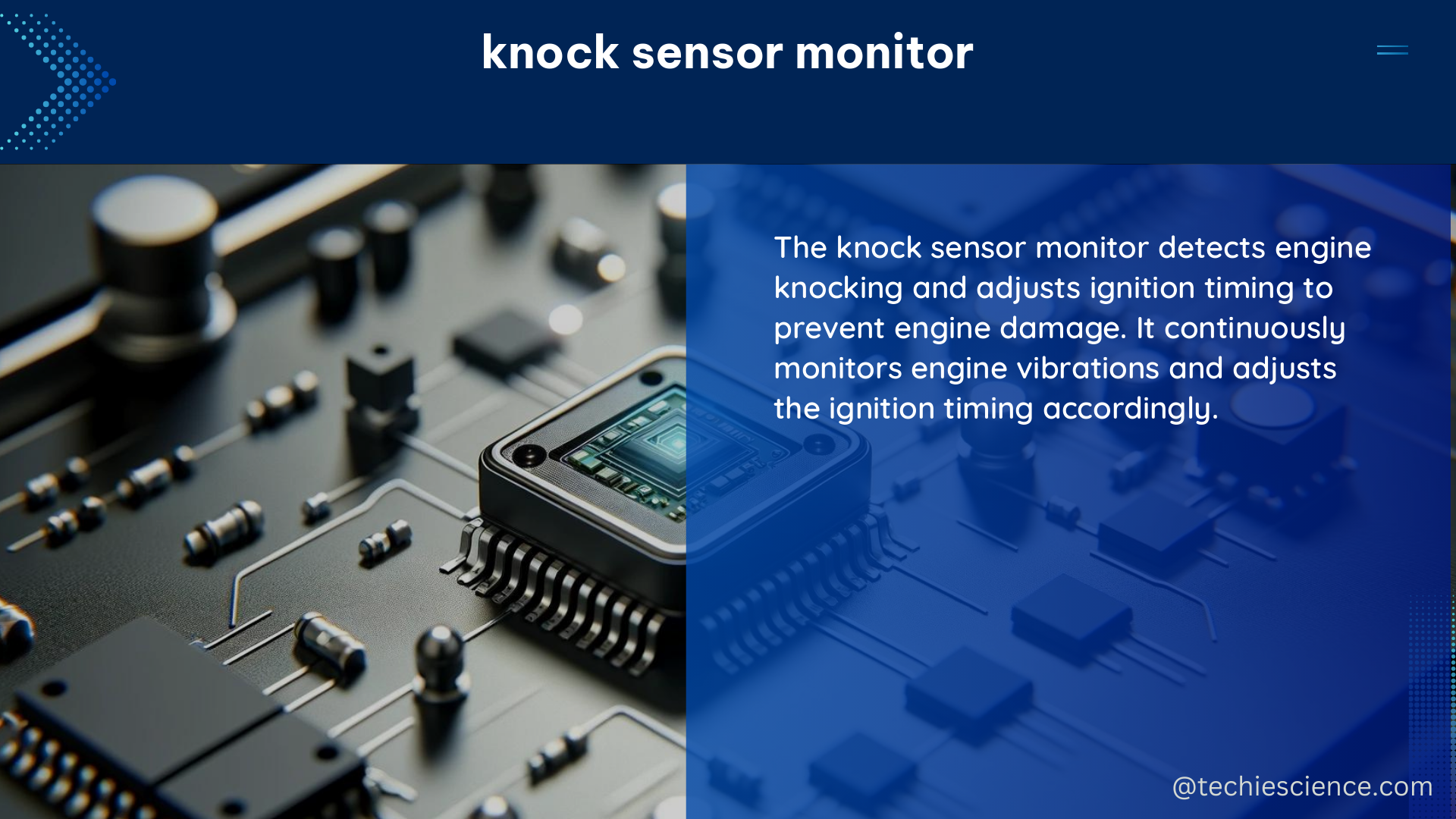The knock sensor monitor is an essential component in modern internal combustion engines, used to detect and prevent engine knocking or pinging. Knocking occurs when the air-fuel mixture in the cylinder ignites too early, causing a shockwave that can damage the engine. The knock sensor monitor detects these vibrations and sends a signal to the engine control unit (ECU) to adjust the ignition timing and fuel injection, preventing engine knocking.
Knock Sensor Monitor: Technical Specifications
The technical specifications of a knock sensor monitor can vary depending on the make and model of the vehicle. However, some common specifications include:
Frequency Response
The knock sensor monitor should have a wide frequency response range to detect knocking vibrations accurately. A typical frequency response range is 5-15 kHz, with the most sensitive range being around 8-12 kHz. This allows the sensor to pick up the high-frequency vibrations associated with engine knocking, while filtering out lower-frequency noise.
Sensitivity
The sensitivity of the knock sensor monitor refers to its ability to detect weak knocking signals. A higher sensitivity value indicates a more sensitive knock sensor. Typical sensitivity values range from 0.5 to 5 mV/g, with higher-end sensors reaching up to 10 mV/g. The sensitivity is influenced by the sensor’s design, materials, and construction.
Temperature Range
The knock sensor monitor should be able to operate in a wide temperature range, typically from -40°C to 150°C (-40°F to 302°F). This ensures reliable performance in various environmental conditions, from cold winter starts to hot summer driving.
Mounting
The knock sensor monitor is typically mounted on the engine block or cylinder head, and should be securely fastened to ensure accurate vibration detection. The mounting location is crucial, as it needs to be close to the source of the knocking vibrations for optimal performance.
Connector
The knock sensor monitor should have a standard connector, such as a coaxial or a four-pin connector, to connect to the ECU. This allows for easy installation and replacement of the sensor if necessary.
DIY Approach to Knock Sensor Monitoring

For those interested in a DIY approach to knock sensor monitoring, there are several resources available online. Here are some tools and techniques you can use:
GT Suite Software
The GT Suite software can be used to model the engine and powertrain of a vehicle, including the intake and exhaust system. This software can help identify geometrical and mechanical values that are not given in the vehicle’s maintenance directive, such as the resonance frequencies of the intake and exhaust system. By understanding these parameters, you can better optimize the knock sensor placement and tuning.
Computer Tomography and Finite Element Methods
Computer tomography (CT) and finite element methods (FEM) can be used to define complex geometries, such as the intake and exhaust system. These techniques allow you to create detailed 3D models of the engine components, which can be used to simulate the airflow and vibration patterns. This information can be valuable in determining the optimal knock sensor placement and sensitivity settings.
CAN BUS Data Analysis
The CAN BUS system can be used to measure and estimate engine parameters, such as acceleration and linear velocity. This data can be used to estimate main engine parameters, such as torque and power, using measured quantities such as car mass and acceleration. By analyzing this data, you can gain a better understanding of the engine’s behavior and how the knock sensor monitor is responding to various driving conditions.
Conclusion
The knock sensor monitor is a critical component in preventing engine knocking and damage. Understanding the technical specifications and using resources such as GT Suite software, computer tomography, finite element methods, and CAN BUS data analysis can help those interested in a DIY approach to knock sensor monitoring. By optimizing the sensor’s placement, sensitivity, and tuning, you can ensure your engine runs smoothly and efficiently, reducing the risk of costly repairs.
References:
- Administrative Changes to AETC TTP11-1, Employment of the F-15 Eagle in a Multi-Role Environment, Second Edition, Air Education and Training Command, 16 January 2020, https://static.e-publishing.af.mil/production/1/aetc/publication/aetcttp11-1/aetcttp11-1.pdf.
- Ubiquitous Mobility for Portland, Portland Bureau of Transportation, 4 February 2016, https://www.portlandoregon.gov/transportation/article/564107.
- I got in trouble for using a mouse jiggler … despite my excellent work, Ask a Manager, 10 January 2023, https://www.askamanager.org/2023/01/i-got-in-trouble-for-using-a-mouse-jiggler-despite-my-excellent-work.html.
- Bobin Maxence, Bimbard Franck, Boukallel Mehdi, Anastassova Margarita, Ammi Mehdi, SpECTRUM: Smart ECosystem for sTRoke patient׳s Upper limbs Monitoring, ScienceDirect, 1 August 2019, https://www.sciencedirect.com/science/article/pii/S2352648318300369.
- Analysis Techniques for Race Car Data Acquisition, Academia.edu, 2016, https://www.academia.edu/88089423/Analysis_Techniques_for_Race_Car_Data_Acquisition.

The lambdageeks.com Core SME Team is a group of experienced subject matter experts from diverse scientific and technical fields including Physics, Chemistry, Technology,Electronics & Electrical Engineering, Automotive, Mechanical Engineering. Our team collaborates to create high-quality, well-researched articles on a wide range of science and technology topics for the lambdageeks.com website.
All Our Senior SME are having more than 7 Years of experience in the respective fields . They are either Working Industry Professionals or assocaited With different Universities. Refer Our Authors Page to get to know About our Core SMEs.